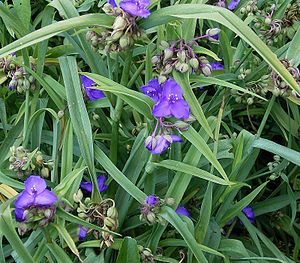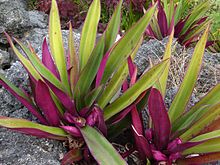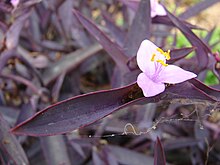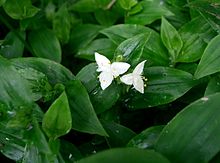Three-masted flowers
| Three-masted flowers | ||||||||||||
|---|---|---|---|---|---|---|---|---|---|---|---|---|

|
||||||||||||
| Systematics | ||||||||||||
|
||||||||||||
| Scientific name | ||||||||||||
| Tradescantia | ||||||||||||
| L. |
Three-masted flowers ( Tradescantia ), also known as god's eyes , are a genus of plants in the Commelina family (Commelinaceae). Many Tradescantia species are suitable as house plants , with differently colored leaves. Some species tolerate low-light locations.
description

They are herbaceous plants of several years , some species are succulent . As usual with monocot plants, the flowers are threefold. The flowers are radial. The two bract circles are clearly different in shape, so they have sepals and petals. The bracts are usually free or only a little overgrown at the base. They form three- chamber capsule fruits with one to two seeds per chamber. When planting in ornamental gardens, it should be noted that some species reproduce like weeds and that it is very difficult to control these plants.
distribution
Their original home is the Neotropic . Some species feral as neophytes .
Systematics
The first description by Carl von Linné in Species Plantarum was published in 1753.
The genus Tradescantia includes the following species and varieties:

- Tradescantia ambigua Mart. ex Schult. & School f.
- Tradescantia anagallidea Seub.
- Tradescantia × andersoniana W. Ludw. & Rohweder
- Tradescantia andrieuxii C.B.Clarke
- Tradescantia boliviana (Hassk.) JRGrant
- Tradescantia bracteata Small ex Britton
- Tradescantia brevifolia (Torr.) Rose
- Tradescantia buckleyi (IMJohnst.) DRHunt
- Tradescantia burchii D.R.Hunt
- Tradescantia cerinthoides Kunth
- Tradescantia chrysophylla M.Pell.
- Tradescantia cirrifera Mart.
- Tradescantia commelinoides Schult. & School f.
-
Tradescantia crassifolia Cav.
- Tradescantia crassifolia var. Crassifolia
- Tradescantia crassifolia var. Acaulis (M.Martens & Galeotti) CBClarke
- Tradescantia crassula Link & Otto
- Tradescantia cymbispatha C.B.Clarke
- Tradescantia deficiens Brandegee
- Tradescantia edwardsiana Tharp
- Tradescantia ernestiana E.S. Anderson & Woodson
- Tradescantia exaltata D.R. Hunt
- Tradescantia fluminensis Vell.
- Tradescantia gentryi D.R. Hunt
- Tradescantia gigantea rose
- Tradescantia gracillima Standl.
- Tradescantia grantii thread
- Tradescantia guiengolensis Matuda
- Tradescantia gypsophila B.L. Turner
- Tradescantia hirsuticaulis Small
- Tradescantia hirsutiflora Bush
- Tradescantia hirta D.R. Hunt
- Tradescantia huehueteca (Standl. & Steyerm.) DRHunt
- Tradescantia humilis rose
- Tradescantia leiandra Torr.
- Tradescantia llamasii Matuda
- Tradescantia longipes E.S. Anderson & Woodson
- Tradescantia masonii Matuda
- Tradescantia maysillesii Matuda
- Tradescantia mcvaughii D.R. Hunt
- Tradescantia mirandae Matuda
- Tradescantia monosperma Brandegee
- Tradescantia multibracteata Ferrarese, Büneker & Canto-Dorow
- Tradescantia mundula Kunth
- Tradescantia murilloae Zamudio, Espejo, López-Ferr. & Ceja
- Tradescantia nuevoleonensis Matuda
-
Tradescantia occidentalis (Britton) Smyth
- Tradescantia occidentalis var. Occidentalis
- Tradescantia occidentalis var. Melanthera MacRoberts
- Tradescantia occidentalis var. Scopulorum (Rose) ESAnderson & Woods.
- Tradescantia ohiensis Raf.
- Tradescantia orchidophylla Rose & Hemsl.
- Tradescantia ozarkana E.S. Anderson & Woodson
- Tradescantia pallida (Rose) DRHunt (Mexican three-masted flower)
- Tradescantia pedicellata Celarian
- Tradescantia peninsularis Brandegee
- Tradescantia petiolaris M.E. Jones
- Tradescantia petricola J.R. Grant
- Tradescantia pinetorum Greene
- Tradescantia plusiantha Standl.
- Tradescantia poelliae D.R.Hunt
- Tradescantia praetermissa M.Pell.
- Tradescantia pygmaea D.R. Hunt
- Tradescantia reverchonii Bush
- Tradescantia roseolens Small
- Tradescantia rozynskii Matuda
- Tradescantia schippii D.R. Hunt
- Tradescantia serrana Hassemer & Funez
- Tradescantia seubertiana M. Pell.
- Tradescantia sillamontana Matuda
- Tradescantia soconuscana Matuda
- Tradescantia spathacea Sw. (Purple-leaved three-masted flower)
- Tradescantia standleyi Steyerm.
- Tradescantia stenophylla Brandegee
- Tradescantia subacaulis Bush
-
Tradescantia subaspera Ker Gawl.
- Tradescantia subaspera var. Subaspera
- Tradescantia subaspera var. Montana (Shuttlew. Ex Small & Vail) ESAnderson & Woods.
- Tradescantia tepoxtlana Matuda
- Tradescantia tharpii E.S. Anderson & Woodson
- Tradescantia umbraculifera Hand .-- Mazz.
- Tradescantia valida G.Brückn.
- Tradescantia velutina Kunth & CDBouché
- Tradescantia virginiana L.
- Tradescantia wrightii Rose & Bush
- Tradescantia zanonia (L.) Sw.
-
Tradescantia zebrina Bosse (zebra ampelkraut)
- Tradescantia zebrina var. Zebrina
- Tradescantia zebrina var. Flocculosa (G.Brückn.) DRHunt
- Tradescantia zebrina var. Mollipila D.R. Hunt
To this extent the genus Tradescantia is monophyletic .
Synonyms of the genus are Campelia Rich. (1808), Zebrina Schnizl. (1849), Rhoeo Hance (1852), Treleasea Rose (1899, nom. Illeg. ICBN Article 53.1) and Setcreasea K.Schum. & Syd. (1901).
Botanical history
The genus was named after John Tradescant the younger and his father John Tradescant the elder . John Tradescant the Younger came to Virginia , one of the first colonized areas in America , in 1637 and sent new plants to England, including bald cypress , lobelia and some species of phlox .
Individual species
The three-masted Virginia flower ( Tradescantia virginiana L. ) is a perennial herbaceous plant with delicate stems and ascending, narrow, long leaves that form a sheath at the base. The flowers are in panicles, consist of three outer and three inner, vividly colored parts, which are usually turquoise blue but also sky blue, pink or white in the varieties. However, today's three-masted flower is probably no longer the original species, since the cultivated forms are usually considered hybrids of the original species with Tradescantia subaspera or Tradescantia pilosa . The six stamens are all the same length, the stamens covered with long, purple hair. The flowers wither after just one day, but as new ones keep appearing, the plant will bloom all summer.
White flowered God's eye, even Rio Dreimasterblume called, ( Tradescantia fluminensis Vell. ( Syn. Tradescantia albiflora Kunth , Tradescantia viridis hort ex. Gentil )) The white-flowered God's eye is long, a small plant with horizontal stem and a few centimeters, fairly wide, completely green Leaves that grow in the cultivated form Tradescantia albiflora cv. aureovittata are striped yellow. The plant rarely blooms and the white flowers are not particularly attractive. She comes from South America .
The Tradescantia cerinthoides Kunth (Syn .: Tradescantia blossfeldiana Mildbr. ) Comes from Argentina and appeared some time ago as a houseplant on the flower market. The whole plant is reddish and covered with long, also reddish hair.
Tradescantia spathacea Sw. (Syn. Rhoeo discolor (L'Hér.) Hance ), looks like a dragon tree. Their up to 20 or 30 cm long leaves are green on the upper side and purple on the underside. She comes from Central America .
literature
- Walter Baumeister: The large illustrated plant book (The large Bertelsmann Lexicon Library; Vol. 16). Bertelsmann, Gütersloh 1969 (detailed, but the system is out of date).
- Walter Erhardt among others: The big pikeperch. Encyclopedia of Plant Names . Volume 2. Verlag Eugen Ulmer, Stuttgart 2008. ISBN 978-3-8001-5406-7
Individual evidence
- ↑ Carl von Linné: Species Plantarum . Lars Salvius, Stockholm 1753, Volume 1, p. 288 ( online ).
- ↑ Rafaël Govaerts (ed.): Tradescantia. In: World Checklist of Selected Plant Families (WCSP) - The Board of Trustees of the Royal Botanic Gardens, Kew . Retrieved August 4, 2018.
- ↑ Jean H. Burns, Robert B. Faden, Scott J. Steppan: Phylogenetic Studies in the Commelinaceae Subfamily Commelinoideae Inferred from Nuclear Ribosomal and Chloroplast DNA Sequences . In: Systematic Botany . Volume 36, Number 2, 2011, pp. 268-276 ( doi: 10.1600 / 036364411X569471 ).









